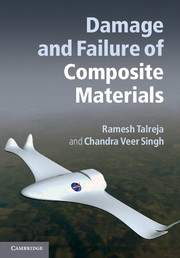Book contents
- Frontmatter
- Contents
- Preface
- 1 Durability assessment of composite structures
- 2 Review of mechanics of composite materials
- 3 Damage in composite materials
- 4 Micro-damage mechanics
- 5 Macro-damage mechanics
- 6 Damage progression
- 7 Damage mechanisms and fatigue-life diagrams
- 8 Future directions
- Author index
- Subject index
- References
3 - Damage in composite materials
Published online by Cambridge University Press: 05 July 2012
- Frontmatter
- Contents
- Preface
- 1 Durability assessment of composite structures
- 2 Review of mechanics of composite materials
- 3 Damage in composite materials
- 4 Micro-damage mechanics
- 5 Macro-damage mechanics
- 6 Damage progression
- 7 Damage mechanisms and fatigue-life diagrams
- 8 Future directions
- Author index
- Subject index
- References
Summary
All structures are designed for a purpose. If the purpose is to carry loads, then a designer must assure that the structure has sufficient load-bearing capacity. If the structure is to function over a period of time, then it must be designed to meet its functionality over that period without losing its integrity.
These are generic structural design issues irrespective of the material used. There are, however, significant differences in design procedures depending on whether the material used is a so-called monolithic material, e.g., a metal or a ceramic, or whether it is a composite material with distinctly different constituents. The heterogeneity of microstructure as well as the anisotropy of properties provide significantly different characteristics to composite materials in how they deform and fail when compared to metals or ceramics. This chapter will review those characteristics. However, before proceeding we need to introduce certain definitions.
Fracture: Conventionally, fracture is understood to be “breakage” of material, or at a more fundamental level, breakage of atomic bonds, manifesting itself in formation of internal surfaces. Examples of fracture in composites are fiber breakage, cracks in matrix, fiber/matrix debonds, and separation of bonded plies (delamination). The field known as fracture mechanics deals with conditions for formation and enlargement of the surfaces of material separation.
Damage: Damage, on the other hand, refers to a collection of all the irreversible changes brought about in a material by a set of energy dissipating physical or chemical processes, resulting from the application of thermomechanical loadings. Damage may inherently be manifested by atomic bond breakage. Unless specified differently, damage is understood to refer to distributed changes. Examples of damage in composites are multiple fiber-bridged matrix cracking in a unidirectional composite, multiple intralaminar cracking in a laminate, local delamination distributed in an interlaminar plane, and fiber/matrix interfacial slip associated with multiple matrix cracking. These damage mechanisms will be explained in some detail later in this chapter. The field of damage mechanics deals with conditions for initiation and progression of distributed changes as well as with consequences of those changes on the response of a material (and by implication, a structure) to external loading.
…
- Type
- Chapter
- Information
- Damage and Failure of Composite Materials , pp. 36 - 56Publisher: Cambridge University PressPrint publication year: 2012
References
- 2
- Cited by



